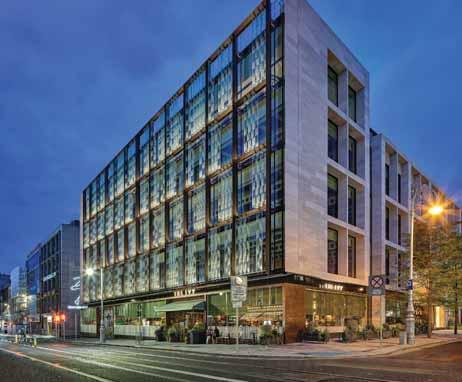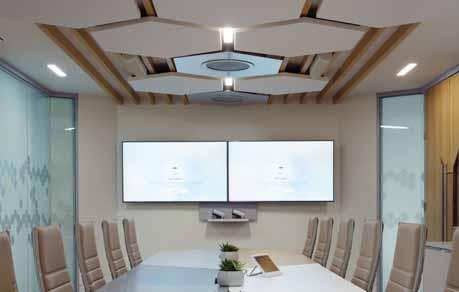
9 minute read
COVID-19
What impact on building services design?
The SARS-CoV2 virus which causes Covid-19 has had a significant impact on all aspects of our lives and none more so than on the built environment. Its emergence has highlighted potential long-term risks that have forced many people to rethink what the workplace is. The early signs indicate that much of this change will focus on remote working, but also that the office environment is here to stay and will need to adapt to meet these emerging demands, writes Cian Dowling, Director, Axiseng.
Advertisement
There are several sources of information on how SARS-CoV2 will impact the design and operation of HVAC systems. However, guidance should be taken from recognisable bodies in that field such as CIBSE, REHVA and ASHRAE.
All these bodies have a common thread to their advice which is that increasing ventilation rates in buildings is the most effective means of reducing the risks to occupants. The principle is to dilute and ideally remove airborne pathogens as much as possible, thus reducing the risk to the users of the space. This will have


an impact on the design and operation of existing buildings, largely due to current thinking that SARS-CoV-2 (“the virus”) is more likely to spread from within the building, and not through the supply of external air. Therefore, increasing fresh air into a building is an important element in reducing the risk of spreading the virus.
Firstly, let’s look at the design of new buildings. Increased fresh air will have an impact on the size of risers and plant spaces required to house them. It will also impact on ceiling void depths, as duct sizes increase to deliver the fresh air to the occupied spaces within the building. Consideration could be given to increasing duct velocities. However, this would need to be balanced with the current Part L requirements for Specific Fan Power (SFP) and resultant potential noise issues. The overall volume increases could be avoided by a reduction in occupation densities in buildings, though we are currently not seeing a reduction in the densities being requested by building clients in the market.

For toilet ventilation, it is often the case that the toilet area has an “extract only” and the makeup air is taken from the adjacent areas such as the corridor or office. While this arrangement is regulation compliant, it does encourage air to be drawn from the office area to the toilet area, which is a confined space.
Consideration should be given to dedicated supply and extract air to the toilets which limits the negative pressure that the toilets are under. This will reduce the transfer of air from the office to the toilet area and will increase the overall fresh air rate in the building. Like all other increases in fresh air intake, this will require additional riser space when compared to an “extract only” system. Cherry Orchard nursing units are a reminder of the extra challenges presented by care
Heat recovery is also an important homes and hospitals. element of any energy efficient building will largely rely on effect on space, capital expenditure building. Separation of supply moving significantly more fresh and operational expenditure. and extract is an important air to control the space than say It will also impact on Part L consideration. Avoiding a fan coil unit (FCU) system. In requirements due to increased recirculation of extract air has recent years this has not been a energy usage. The increased levels always been an important popular option for owner occupiers of fresh air in the winter months consideration when locating or developers but perhaps it has will tend to decrease internal intakes and discharges, but this more merit when consideration humidity as more dry air is being will become more important in is given to increasing fresh air introduced into the building. the context of managing the rates. It is unlikely to appeal Having humidity measurement as virus spread within a building. to most, but perhaps worth part of the BMS within the occupied
Increasing the rate of filtration is considering. zones will add little cost at design not something that is advised in There is also some evidence that stage and will give great comfort the fight against the spread of occupants are more susceptible to both building operators and the virus by any of the bodies to infection when the relative occupants. noted already so normal rates humidity is below 30%. This can For building operators, it is of filtration continue to apply. happen during the colder months essential that they fully understand
An alternative design option when the HVAC systems are largely the operation of the ventilation may well be to consider natural in heating mode. Consideration system. There are several types of ventilation or displacement. An should be given to humidity these in operation and small engineered, naturally-ventilated control though this will have an variants could mean the difference in them understanding fully how their supply and extract systems “ Any ventilation system using mixing as a means of heat recovery will need to be set to operate on full fresh air. operate or not. From an operation point of view increased running time on air handling plant should be considered. Also, where demand control is in use this should be set up to achieve maximum fresh air


to the building. Toilet ventilation plant should be run 24/7, ensuring that a negative pressure is maintained in toilet cubicles to minimise aerosols transmission. This will have an impact on energy usage but is generally seen as a small penalty when considered in the context of the pandemic being experienced.
A significant consideration in the operation of AHU, and in particular those with heat recovery, is to ensure that there is no significant leakage from the extract to the supply. This can be The principles of wellbeing are very well incorporated in the Axa fit-out. caused by poorly-designed or commissioned AHUs where the This should be checked and fails on a system, care is needed positive extract pressure can adjusted if required. Similarly, to ensure that the positive exceed the positive supply when maintenance is being extract pressure does not exceed pressure at the heat exchanger. carried out, or when a supply fan the supply pressure at the heat exchanger. Also, any ventilation system using mixing as a means of heat recovery will need to be set to operate on full fresh air. While clogged filters are not a contamination source in the context of SARS-CoV2, they reduce supply airflow which has a negative effect on the ability to remove and dilute concentrations of contaminant. Thus, filters should be replaced according to normal procedure when pressure or time limits are exceeded, or according to scheduled maintenance. The emergence of UV filtration is also an interesting development. As noted, none of the bodies recommend the increase of filtration of outside air. However, could UV filtration within say an FCU provide a means of continuously filtering the air within the occupied space as it is continuously recirculated through the FCU? There are currently uncertainties about a variety of factors affecting UV performance, including dosage, wavelength and exposure time. A life-cycle analysis would be Pharmaceutical facilities are perhaps the better examples of best practice in the industry. required on this as it has capital
and maintenance cost considerations.
In areas where it is difficult to increase ventilation rates, it may be appropriate to consider using local air cleaning and disinfection devices. The most appropriate devices are likely to be local HEPA filtration units or those that use UV radiation. Although neither of these have been proven to fully eliminate the virus, there is evidence that they can assist.
Considerations not related to the ventilation system would be the use of contactless technologies where possible.
faced by the retail and hospitality setor.
Contactless sanitaryware has long been in use and would be an obvious move. However, there are other contactless technologies which can be considered.
Access control can be operated on a contactless basis. This could be further developed to allow doors to motor open, but this can impact on people movements in a building as motorised doors are generally slower to open than the manual version. To avoid this perhaps some doors on main routes could be held open during office hours when security is less of a risk. There are also system integrators who can provide thermal scanning, facial recognition and checking that hand sanitisers have been used as part of the access control system.
Lifts are another area to be looked at. These are common points of contact for the majority of occupants in a building. Lift manufactures have responded to this by integrating mobile phone apps in their destination control systems that allow the lift to be used without the need to touch any surfaces. This does not address the issue of social
Brewdog Dublin Outpost, Capital Dock, is a typical example of the challenges being

distancing within lifts and CIBSE still recommends lift car occupancy should only be one person per car up to a rated load of less than 800 kg, and one person per square meter for lifts over this size. This has an obvious impact on lift travel times and handling capacity. It remains to be seen whether bodies such as The British Council of Offices (BCO) alter their current guidance to take account of this but, for now, buildings continue to be designed in accordance with BCO 2014 guidance.
Water usage in buildings has long been a point of debate within the building services industry. Several of the water storage requirements as set down by water by-laws are out of sync with current water usage and the drive for low-flow devices that organisations such as LEED and BREEAM have implemented. This will be further exasperated by the lower density of occupants within buildings. SARS-CoV2 is not necessarily present in the water system but, due to the lower usage from reduced occupancy, there may be stagnant water in systems which could result in bacteria growth and legionella risks.
One of the most talked about trends over the last few months is the move to cloud-based solutions and video conferencing for meetings. This is likely to continue even when people return to the office. Covid-19 will mean significant changes in tenant IT due diligence, connectivity requirements, and resilience of digital infrastructure to support businesses. This will, at a minimum, mean that developers will need to be able to demonstrate good connectivity, and may mean more developers need to consider Wiredscore certification.
We see that the office is here to stay, though it is certainly going through a major change in how we approach HVAC design and the operation of buildings. Occupants of all buildings have had to embrace home working but there is a clear message that people miss the interaction of the workspace. Our industry has shown an ability to embrace change in many ways over the years and will continue to do this as we work our way through this pandemic. This will enhance the resilience of the buildings we construct and operate, and will no doubt bring new technologies with it. Q







